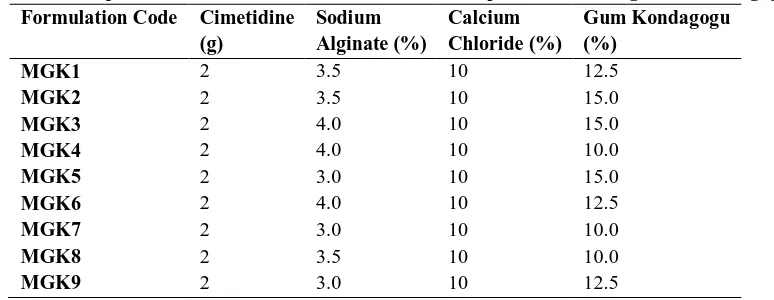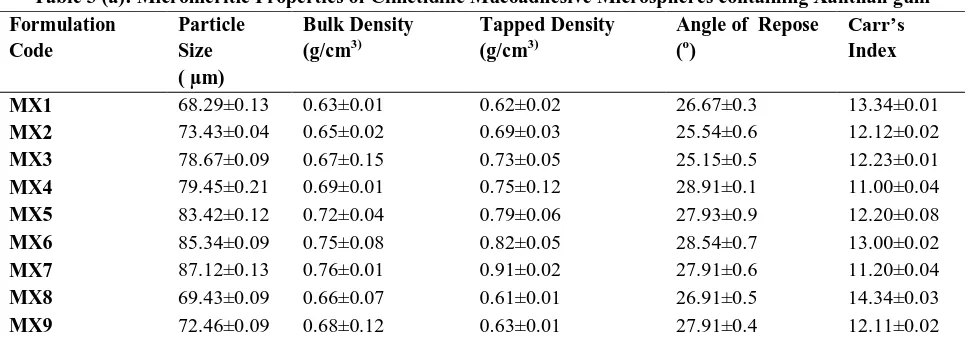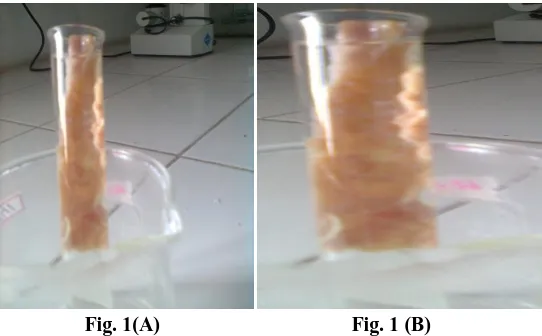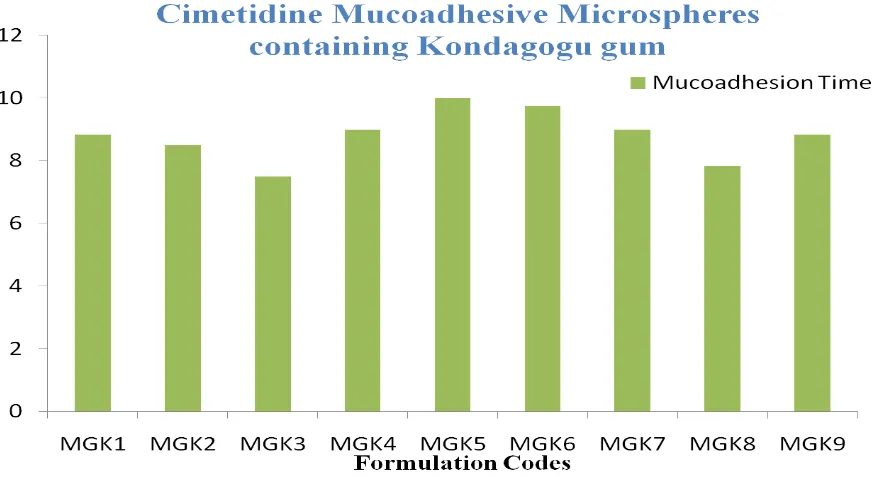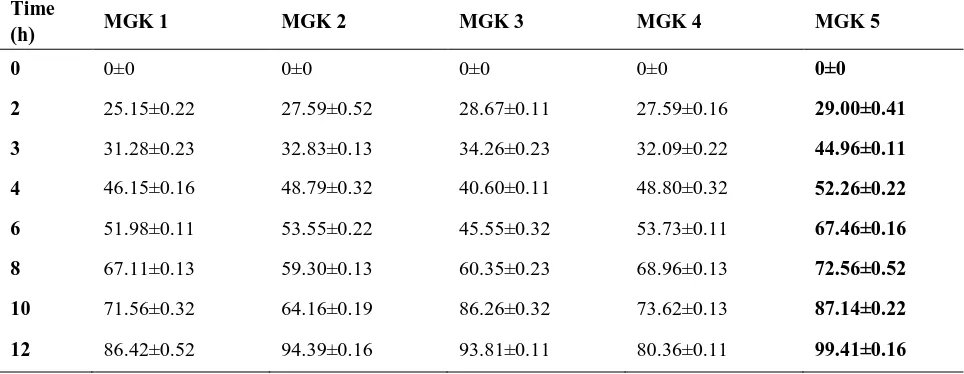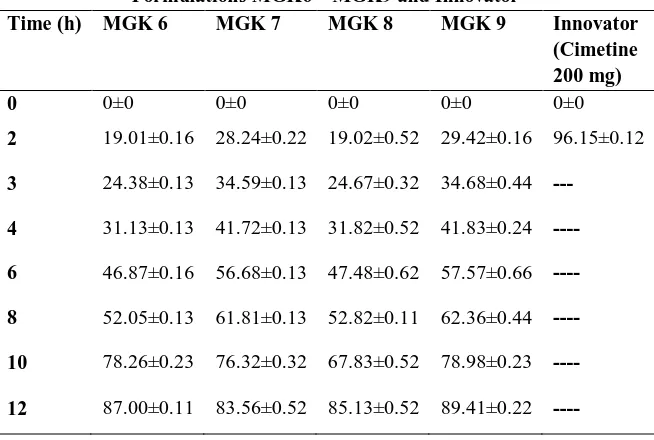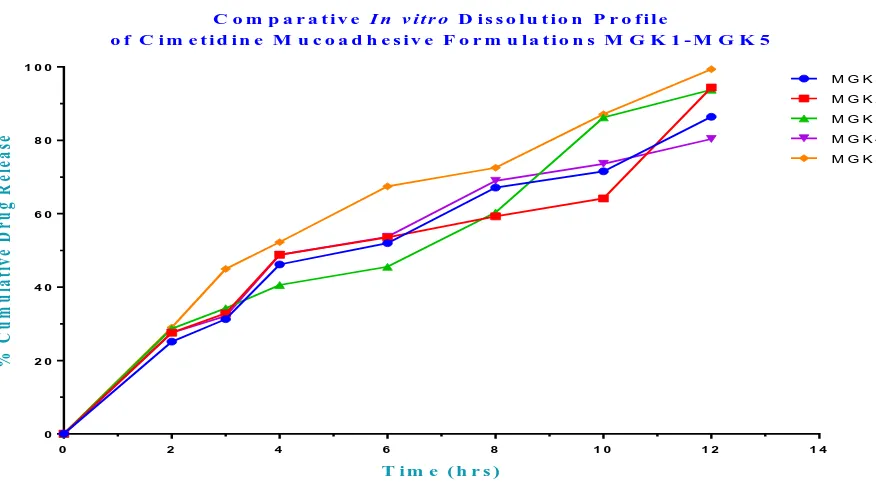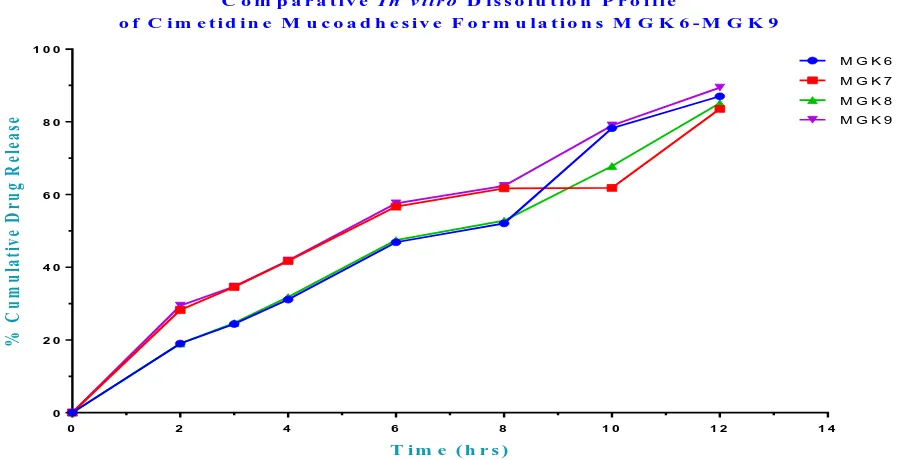IJPAR |Vol.5 | Issue 3 | July - Sep -2016
Journal Home page: www.ijpar.com
Research article Open Access
Formulation and evaluation of mucoadhesive microspheres of cimetidine
SK. Arifa Begum
1,2*, D. Basava Raju
31
Vijaya Institute of Pharmaceutical Sciences for Women, Vijayawada, Andhra Pradesh, India.
2
Jawaharlal Nehru Technological University, Kukatpally, Hyderabad-500072, Telangana, India.
3
Shri Vishnu College of Pharmacy, Bhimavaram, Andhra Pradesh, India.
*Corresponding Author: Shaik Arifa Begum
E-mail ID: arifashaik2007@gmail.com
ABSTRACT
The intention of the present study is to formulate mucoadhesive microspheres containing cimetidine by employing xanthan gum & gum kondagogu as mucoadhesive agent and by adapting ionotropic gelation technique. Response Surface Composite design was employed to study the effect of independent variables, polymer concentration (X1) and sodium alginate concentration (X2) on dependent variables mucoadhesion time. The best batch exhibited a high drug entrapment efficiency of 97.12% and a swelling index of 96.98%; percentage mucoadhesion after 10 h was 98%. The drug release was also sustained for 12 h. The prepared mucoadhesive microspheres were characterized for various properties like preformulation, flow properties, in vitro mucoadhesion, in vitro drug release, entrapment efficiency and surface properties. The external and internal surface morphological characteristics of mucoadhesive microspheres were investigated using Scanning Electron Microscope (SEM). The formulation which showed better flow properties, in vitro drug release and entrapment efficiency was selected as optimized formulation i.e., formulation MGK5. The in vitro release profiles from optimized formulations were applied on various release kinetic models of drug and suggested that the drug release from microspheres followed non-fickian diffusion. The optimized formulations MGK5 was subjected to stability studies for six months at 400 ±20C & 75±5%RH as per ICH guidelines and result showed that there were no changes in physical parameters, formulation parameters and in vitro release studies.
Keywords: Mucoadhesive Microspheres, Cimetidine, Factorial Design, In vitro study.
INTRODUCTION
Microsphere carrier systems made from the naturally occurring biodegradable polymers have attracted considerable attention for several years in sustained drug delivery. Recently, dosage forms
drug delivery systems [1-3]. They have varied applications and are prepared using assorted polymers. However, the success of these microspheres is limited owing to their short residence time at the site of absorption. It would, therefore, be advantageous to have means for providing an intimate contact of the drug delivery system with the absorbing membranes [4]. This can be achieved by coupling bioadhesion characteristics to microspheres and developing bioadhesive microspheres. Bioadhesive microspheres have advantages such as efficient absorption and enhanced bioavailability of drugs owing to a high surface-to-volume ratio, a much more intimate contact with the mucus layer and specific targeting of drugs to the absorption site. [5]
Cimetidine is a histamine H2 receptor antagonist, which is widely prescribed in gastric ulcers, duodenal ulcers and gastroesophageal reflux disease. It is poorly absorbed from the lower gastrointestinal tract and has a short elimination half-life (~ 2 h) [6]. The purpose of the work was to prepare cimetidine (CM) microspheres in order to achieve an extended retention in the upper GIT, which may result in enhanced absorption and thereby improved bioavailability.
MATERIALS AND METHODS
Materials
Cimetidine was obtained as a gift sample from Aurobindo Pharma Limited, Hyderabad, India. Sodium alginate was obtained from Pruthvi
Chemicals, Mumbai. Sodium Carboxy Methyl Cellulose, Xanthan gum and Gum Kondagogu were obtained from MSN Labs Ltd., Hyderabad. All other chemicals were of Pharmaceutical grade.
Method
Cimetidine mucoadhesive microspheres were prepared using polymers sodium alginate, chitosan, sodium CMC by ionotropic gelation method. A 32 full factorial design was employed to study the effect of independent variables, polymer-to-drug ratio (X1) and stirring speed (X2) on dependent variables percentage mucoadhesion, drug entrapment efficiency and swelling index. Different formulations were prepared by using different concentrations of polymers and mucoadhesive agent showed in Table 1 & 2. Cimetidine mucoadhesive microspheres were prepared using polymers sodium alginate & xanthan gum and gum kondagogu were used in different concentrations by ionotropic gelation method. In this method, weighed quantity of cimetidine was added to 100 ml sodium alginate, xanthan gum and gum kondagogu solution were thoroughly mixed at 500 rpm. Resultant solution was extruded drop wise with the help of syringe and needle into 100 ml aqueous calcium chloride solution and stirred at 100 rpm. After stirring for 30 min, the obtained microspheres were washed with water and dried at 600C for 4 h in a hot air oven and stored in desiccators [7].
Table 1 (a): Optimization of Cimetidine Mucoadhesive Microspheres containing Xanthan gum
Factor Name Minimum Maximum -1 Actual +1 Actual Mean Std. Dev.
A Sodium
Alginate (%)
3.00 4.00 3.00 4.00 3.50 0.41
B Xanthan
Gum (%)
15.00 20.00 15.00 20.00 17.50 2.04
Table 1 (b): Composition of Cimetidine Mucoadhesive Microspheres containing Xanthan gum Formulation Code Cimetidine
(g) Sodium Alginate (%) Calcium Chloride (%) Xanthan Gum (%)
MX1 2 3.5 10 17.5
MX2 2 4.0 10 20.0
MX3 2 3.5 10 20.0
MX4 2 3.0 10 17.5
MX5 2 3.0 10 15.0
MX7 2 3.0 10 20.0
MX8 2 3.5 10 15.0
MX9 2 4.0 10 17.5
Table 2 (a): Optimization of Cimetidine Mucoadhesive Microspheres containing Xanthan gum
Factor Name Minimum Maximum -1 Actual +1
Actual
Mean Std. Dev.
A Sodium
Alginate (%)
3.00 4.00 3.00 4.00 3.50 0.41
B Gum Kondagogu
(%)
10.00 15.00 10.00 15.00 12.50 2.04
Table 2 (b): Composition of Cimetidine Mucoadhesive Microspheres containing Gum Kondagogu Formulation Code Cimetidine
(g)
Sodium Alginate (%)
Calcium Chloride (%)
Gum Kondagogu (%)
MGK1 2 3.5 10 12.5
MGK2 2 3.5 10 15.0
MGK3 2 4.0 10 15.0
MGK4 2 4.0 10 10.0
MGK5 2 3.0 10 15.0
MGK6 2 4.0 10 12.5
MGK7 2 3.0 10 10.0
MGK8 2 3.5 10 10.0
MGK9 2 3.0 10 12.5
EVALUATION STUDIES
Cimetidine mucoadhesive microspheres were evaluated for determination of particle size, bulk density, tapped density, angle of repose, compressibility index, swelling index, drug entrapment efficiency and percentage yield [8-10].
Mucoadhesion Study
The in vitro mucoadhesive test was carried out
using small intestine from chicken. The small intestinal tissue was excised and flushed with saline. Five centimeter segment of jejunum were averted using a glass rod. Ligature was placed at
both ends of the segment.100 microspheres were scattered uniformly on the averted sac from the position of 2 cm above. Then the sac was suspended in a 50 ml tube containing 40 ml of saline by the wire, to immerse in the saline completely. The sac were incubated at 370C and agitated horizontally. The sac were taken out of the medium after immersion for 1, 2, 3, 4, 5, 6, 7, 8, 9 and 10 h, immediately repositioned as before in a similar tube containing 40 ml of fresh saline and unbound microspheres were counted [11]. The adhering percent was presented by the following equation.
In vitro Drug Release Studies
Release rate of drug from mucoadhesive microspheres was carried out using USP dissolution apparatus [12]. Accurately weighed amount of microspheres from each batch were subjected to dissolution studies in triplicate manner. At appropriate intervals up to 12 h,
The amount of drug released was calculated from the calibration curve of the same dissolution medium.
Conditions for mucoadhesive microspheres: Performed using USP dissolution apparatus II. Dissolution medium – 0.1N HCl
Temperature – 37 ± 0.50C Stirring speed – 100 rpm Bath volume – 900 ml
Time intervals – 0, 2, 3, 4, 6, 8, 10 & 12 h.
Kinetic Modeling of Drug Release
In order to understand the kinetics and mechanism of drug release, the result of the in
vitro dissolution study of microspheres were fitted
with various kinetic equations like zero order as cumulative percentage drug released Vs time, first order as log percentage of drug remaining to be released Vs time, Higuchi’s model cumulative percentage drug released Vs. square root of time. r² and K values were calculated for the linear curves obtained by regression analysis of the above plots [13].
Drug Excipient Compatability Studies:
The drug excipient compatibility studies were carried out by Fourier Transmission Infrared Spectroscopy (FTIR) method and Differential Scanning Colorimetry (DSC) method [14].
Fourier Transform Infrared Spectroscopy (FTIR)
FTIR spectra for pure drug, physical mixture and optimized formulations were recorded using a Fourier transform Infrared spectrophotometer. The analysis was carried out in Shimadzu-IR Affinity 1 Spectrophotometer. The samples were dispersed in KBr and compressed into disc/pellet by application of pressure. The pellets were placed in the light path for recording the IR spectra. The scanning range was 400-4000 cm-1 and the resolution was 1 cm-1.
Differential Scanning Calorimetry (DSC)
Differential Scanning Calorimetry (DSC) studies were carried out using DSC 60, having TA60 software, Shimadzu, Japan. Samples were accurately weighed and heated in sealed aluminum pans at a rate of 10°C/ min between 25 and 350°C temperature range under nitrogen atmosphere. Empty aluminum pan was used as a reference [15].
SEM Studies
The surface and shape characteristics of pellets were determined by scanning electron microscopy (SEM) (HITACHI, S-3700N). Photographs were taken and recorded at suitable magnification.
Stability Studies
Accelerated stability studies were carried out at 40 0C / 75 % RH for the best formulations for 6 months. The microspheres were characterized for the percentage yield, entrapment efficiency and cumulative % drug released during the stability study period [16].
Factorial Design
A statistical model incorporating interactive and polynomial terms was used to evaluate the responses:
Y = b0 + b1X1 + b2X2 + b12X1X2 + b11X21 + b22X22;
Where, Y is the dependent variable, b0 is the arithmetic mean response of the 9 runs, and bi is the estimated coefficient for the factor Xi. The main
effects (X1 and X2) represent the average result of
changing one factor at a time from its low to high value. The interaction terms (X1X2) show how the
response changes when 2 factors are simultaneously changed. The polynomial terms (X1 2 and X2 2) are included to investigate nonlinearity [6].
RESULTS AND DISSCUSSION
Micromeritic Properties
Particle size of all the formulations containing xanthan gum MX1 to MX9 varied from 65.29 ± 0.13 µm to 87.12±0.13 and formulation containing gum kondagogu varied from MGK1 to MGK9 66.89±0.10 µm to 91.45±0.12 µm. The formulation MGK5 showed the particle size 70.04±0.11µm.
The bulk density of all the formulations containing xanthan gum MX1 to MX9 was measured and it was ranged from 0.63 g/cm³ to 0.75 g/cm³ and formulation containing gum kondagogu varied from MGK1 to MGK9 also measured and it was ranged from 0.63 g/cm³ to 0.89 g/cm³. The tapped density of all the formulations were measured and ranged between 0.62 g/cm³ - 0.91 g/cm³.
The compressibility index values were found to be in the range of 9.34 to 14.34%. These findings indicated that the all batches of formulation
exhibited good flow properties and depicted as shown in Table 3 (a) and (b).
Table 3 (a): Micromeritic Properties of Cimetidine Mucoadhesive Microspheres containing Xanthan gum Formulation Code Particle Size ( µm) Bulk Density (g/cm3) Tapped Density (g/cm3)
Angle of Repose (o)
Carr’s Index
MX1 68.29±0.13 0.63±0.01 0.62±0.02 26.67±0.3 13.34±0.01
MX2 73.43±0.04 0.65±0.02 0.69±0.03 25.54±0.6 12.12±0.02
MX3 78.67±0.09 0.67±0.15 0.73±0.05 25.15±0.5 12.23±0.01
MX4 79.45±0.21 0.69±0.01 0.75±0.12 28.91±0.1 11.00±0.04
MX5 83.42±0.12 0.72±0.04 0.79±0.06 27.93±0.9 12.20±0.08
MX6 85.34±0.09 0.75±0.08 0.82±0.05 28.54±0.7 13.00±0.02
MX7 87.12±0.13 0.76±0.01 0.91±0.02 27.91±0.6 11.20±0.04
MX8 69.43±0.09 0.66±0.07 0.61±0.01 26.91±0.5 14.34±0.03
MX9 72.46±0.09 0.68±0.12 0.63±0.01 27.91±0.4 12.11±0.02
Table 3 (b): Micromeritic Properties Cimetidine Mucoadhesive Microsphere containing Gum Kondagogu Formulation Code Particle Size ( µm) Bulk Density (g/cm3) Tapped Density (g/cm3)
Angle of Repose (o)
Carr’s Index
MGK1 66.89±0.10 0.72±0.02 0.68±0.01 30.24±0.2 12.12±0.12
MGK2 85.94±0.11 0.74±0.02 0.72±0.02 27.93±0.2 12.23±0.13
MGK3 88.94±0.11 0.79±0.03 0.75±0.01 25.34±0.13 09.34±0.14
MGK4 89.04±0.21 0.81±0.03 0.76±0.03 26.54±0.15 12.34±0.14
MGK5 70.04±0.11 0.63±0.11 0.72±0.04 25.34±0.1 09.34±0.04
MGK6 77.98±0.10 0.68±0.12 0.78±0.01 23.61±0.23 12.27±0.17
MGK7 89.54±0.21 0.73±0.11 0.89±0.01 27.61±0.14 10.92±0.12
MGK8 91.45±0.12 0.83±0.03 0.83±0.09 27.91±0.11 11.45±0.15
MGK9 81.45±0.21 0.89±0.01 0.77±0.08 32.61±0.12 13.83±0.13
Percentage Yield, Entrapment Efficiency & Swelling Index
The mucoadhesive microspheres of formulation showed the percentage yield values ranging from 75.45% to 99.30%. The entrapment efficiency values of all the 18 formulations ranged from 76.00% to 97.12%. All the formulations showed the swelling of microspheres. The swelling of the formulation MGK5 was found to be 96.98%. The formulation MGK5 showed better % yield, entrapment efficiency and swelling index of 99.30%, 97.12% and 96.98% respectively, when
compared with other formulations and the results are showed in Table 4 (a) and (b) .
Mucoadhesion Study
The in vitro mucoadhesive test was carried out
using chicken small intestine. All the 18 formulations of mucoadhesive microspheres were exposed to mucoadhesion test and setup for mucoahesion study was showed in Figure 2 - 3 and results were depicted in Table 4 (a) & 4 (b).
Fig. 1(A) Fig. 1 (B)
Fig. 1: Pictorial Diagram Showing Mucoadhesive Property of Mucoadhesive Microspheres in Chic Intestine at 0 min (A) & after 8 h (B)
In vitro Drug Release Studies
The optimized formulation MGK 5 was found to provide the best drug release when compared with other formulations. The % drug release of formulation MGK5 was found to be 99.41 ± 0.16%
in 12 h. The drug release of optimized formulation MGK5 was in controlled manner when compared with innovator product cimetine i.e. 96.15% within 2 h and results were showed in Table 5 & 6 &
Figures 4 – 8.
Table 4 (a): Evaluation Report of Cimetidine Mucoadhesive Microspheres containing Xanthan gum Formulation
Code
Percentage Yield (%)
Entrapment Efficiency (%)
Swelling Index (%)
Mucoadhesion Time (h)
MX1 75.45±1.43 76.00±1.86 72.11±1.14 7.75
MX2 81.38±2.43 82.03±1.32 78.34±1.07 8.5
MX3 82.97±2.56 84.04±1.72 82.89±1.28 7.83
MX4 85.00±2.31 86.00±1.87 84.56±1.46 9
MX5 87.02±2.12 88.72±1.98 85.23±1.21 9.5
MX6 96.03±1.54 95.03±1.22 91.12±1.42 9
MX7 96.10±0.43 97.01±1.73 91.23±1.53 9.75
MX8 81.08±1.87 80.02±1.39 69.12±1.08 9.5
MX9 83.00±2.41 82.05±1.57 70.12±1.22 9.30
Table 4 (b): Evaluation Report of Cimetidine Mucoadhesive Microspheres containing Gum Kondagogu Formulation Code Percentage Yield
(%)
Entrapment Efficiency (%) Swelling Index (%) Mucoadhesion Time (h)
MGK1 84.00± 85.00±1.15 75.22±1.22 8.83
MGK2 89.00± 88.25±1.18 84.34±1.11 8.5
MGK3 98.90± 97.07±1.17 96.08±1.13 7.5
MGK4 90.72 ± 89.67±1.76 90.03±1.13 9
MGK5 99.30±0.16 97.12±1.11 96.98±1.54 10
MGK6 93.02± 96.95±1.13 96.58±1.22 9.75
MGK7 92.00± 91.03±1.03 94.08±1.32 9
MGK8 98.90± 97.74±1.04 96.79±1.65 7.83
Mathematical Modelling of Optimized Formula of Mucoadhesive Microspheres
The in vitro release profiles from optimized
formulations were applied on various kinetic models. The best fit with the highest correlation coefficient was observed in zero order and Higuchi
model, indicating diffusion controlled principle i.e., showed in Table 7. Further, the n value obtained from the Korsmeyer plots i.e., 1.075 suggested that the drug release from microspheres was anomalous non-fickian diffusion.
Fig. 2: Comparsion of In vitro Mucoadhesion Time of Cimetidine Mucoadhesive Microspheres containing Xanthan gum (MX1 to MX9)
Table 5 (a): In vitro Release Study of Cimetidine Mucoadhesive Microspheres containing Xanthan gum Formulations MX1 – MX5
Time (h) MX1 MX2 MX3 MX4 MX5
0 0±0 0±0 0±0 0±0 0±0
2 24.78±0.22 24.05±0.52 25.07±0.45 25.16±0.22 22.86±0.98
3 37.61±0.23 40.62±0.16 33.42±0.16 43.80±0.21 33.85±0.78
4 49.67±0.32 43.00±0.13 48.98±0.22 46.43±0.11 45.96±0.76
6 60.77±0.16 54.16±0.22 50.17±0.52 50.20±0.13 57.18±0.66
8 76.31±0.32 66.95±0.23 62.00±0.34 60.78±0.21 67.86±0.44
10 81.08±0.12 78.09±0.32 74.82±0.22 71.96±0.22 79.77±0.12
12 82.83±0.23 90.50±0.16 92.94±0.23 84.80±0.16 81.21±0.32
Table 5 (b): In vitro Cimetidine Mucoadhesive Microspheres containing Xanthan gum Formulations MX6 – MX9 and Innovator
Time (h) MX6 MX7 MX8 MX9 Innovator
(Cimetine 200 mg)
0 0±0 0±0 0±0 0±0 0±0
2 22.86±0.14 24.03±0.22 22.42±0.21 25.76±0.22 96.15±0.12
3 32.85±0.18 34.20±0.11 31.39±0.22 31.43±0.52 ---
4 44.96±0.16 46.81±0.21 43.35±0.16 43.54±0.34 ----
6 56.18±0.33 57.83±0.13 54.65±0.23 54.57±0.66 ----
8 66.79±0.12 70.22±0.33 65.29±0.32 60.36±0.44 ----
10 78.52±0.22 89.73±0.41 77.02±0.16 75.42±0.12 ----
12 82.17±0.11 94.54±0.11 86.70±0.13 89.94±0.32 ----
Table 6 (a): In vitro Release Study of Cimetidine Mucoadhesive Microspheres containing Gum Kondagogu Formulations MGK1 – MGK5
Time
(h) MGK 1 MGK 2 MGK 3 MGK 4 MGK 5
0 0±0 0±0 0±0 0±0 0±0
2 25.15±0.22 27.59±0.52 28.67±0.11 27.59±0.16 29.00±0.41
3 31.28±0.23 32.83±0.13 34.26±0.23 32.09±0.22 44.96±0.11
4 46.15±0.16 48.79±0.32 40.60±0.11 48.80±0.32 52.26±0.22
6 51.98±0.11 53.55±0.22 45.55±0.32 53.73±0.11 67.46±0.16
8 67.11±0.13 59.30±0.13 60.35±0.23 68.96±0.13 72.56±0.52
10 71.56±0.32 64.16±0.19 86.26±0.32 73.62±0.13 87.14±0.22
Table 6 (b): In vitro Release Study of Cimetidine Mucoadhesive Microspheres containing Gum Kondagogu Formulations MGK6 – MGK9 and Innovator
Time (h) MGK 6 MGK 7 MGK 8 MGK 9 Innovator
(Cimetine 200 mg)
0 0±0 0±0 0±0 0±0 0±0
2 19.01±0.16 28.24±0.22 19.02±0.52 29.42±0.16 96.15±0.12
3 24.38±0.13 34.59±0.13 24.67±0.32 34.68±0.44 ---
4 31.13±0.13 41.72±0.13 31.82±0.52 41.83±0.24 ----
6 46.87±0.16 56.68±0.13 47.48±0.62 57.57±0.66 ----
8 52.05±0.13 61.81±0.13 52.82±0.11 62.36±0.44 ----
10 78.26±0.23 76.32±0.32 67.83±0.52 78.98±0.23 ----
12 87.00±0.11 83.56±0.52 85.13±0.52 89.41±0.22 ----
Fig. 4: In vitro Release Profiles of Cimetidine Mucoadhesive Microsphere containing xanthan gum formulations MX1 – MX5
C o m p a r a t i v e I n v i t r o D i s s o l u t i o n P r o f i l e o f C e m e t i d i n e F o r m u l a t i o n s M X 1 - M X 5
T i m e ( h r s )
%
C
u
m
u
la
ti
v
e
D
r
u
g
R
e
le
a
se
0 2 4 6 8 1 0 1 2 1 4
0 2 0 4 0 6 0 8 0 1 0 0
Fig. 5: In vitro Release Profiles of Cimetidine Mucoadhesive Microspheres containing Xanthan gum Formulations MX6 – MX9
Fig. 6: In vitro Release Profiles of Cimetidine Mucoadhesive Microsphere containing Gum Kondagogu formulations MGK1 – MGK5
C o m p a r a t i v e I n v i t r o D i s s o l u t i o n P r o f i l e
o f C i m e t i d i n e M u c o a d h e s i v e F o r m u l a t i o n s M X 6 - M X 9
T i m e ( h r s )
%
C
u
m
u
la
ti
v
e
D
ru
g
R
el
ea
se
0 2 4 6 8 1 0 1 2 1 4
0 2 0 4 0 6 0 8 0 1 0 0
M X 6 M X 7 M X 8 M X 9
C o m p a r a t i v e I n v i t r o D i s s o l u t i o n P r o f i l e
o f C i m e t i d i n e M u c o a d h e s i v e F o r m u l a t i o n s M G K 1 - M G K 5
T i m e ( h r s )
%
C
u
m
u
la
ti
v
e
D
ru
g
R
el
ea
se
0 2 4 6 8 1 0 1 2 1 4
0 2 0 4 0 6 0 8 0 1 0 0
Fig. 7: In vitro Release Profiles of Cimetidine Mucoadhesive Microspheres containing Gum Kondagogu Formulations MGK6 – MGK9
Fig. 8: Comparative In vitro Dissolution Profile of optimized Cimetidine Mucoadhesive Formulations MGK 5 & Innovator (Cimetine 200 mg)
C o m p a r a t i v e I n v i t r o D i s s o l u t i o n P r o f i l e
o f C i m e t i d i n e M u c o a d h e s i v e F o r m u l a t i o n s M G K 6 - M G K 9
T i m e ( h r s )
%
C
u
m
u
la
ti
v
e
D
ru
g
R
el
ea
se
0 2 4 6 8 1 0 1 2 1 4
0 2 0 4 0 6 0 8 0 1 0 0
M G K 6 M G K 7 M G K 8 M G K 9
C o m p a r a t i v e I n v i t r o D i s s o l u t i o n P r o f i l e
o f o p t i m i z e d C i m e t i d i n e M u c o a d h e s i v e F o r m u l a t i o n s M G K 5 & I n n o v a t o r ( C i m e t i n e 2 0 0 m g )
T i m e ( h r s )
%
C
u
m
u
la
ti
v
e
D
r
u
g
R
e
le
a
se
0 2 4 6 8 1 0 1 2 1 4
0 2 0 4 0 6 0 8 0 1 0 0
M G K 5
Table 7: Release Kinetics of Optimized Formulation of Mucoadhesive Microspheres S.No. Formulation
Code
Zero order (R2) First order (R2)
Higuchi (R2) Korsmeyer-peppas (R2)
Korsmeyer-peppas (n)
1. MGK5 0.999 0.979 0.948 0.712 1.075
Characterization of Cimetidine Mucoadhesive Microspheres
Fourier Transform Infrared Spectroscopy (FTIR)
Drug polymer interaction was checked by comparing the IR spectra of the physical mixture of drug with the excipients used with the IR spectrum of pure drug Figure 9 (a) and optimized formulation (MGK5) Figure 9 (b), and results found that there were no possible interaction between drug and polymer. The FTIR spectrum of cimetidine showed peaks corresponding to (C-H)
bending at 1346.36 cm-1 and aromatic group (C=C) at 1501.63 cm-1, alkane group (C-C) at 1202.66 cm
-1
, Amine group (C-N) at 1281.74 cm-1, Imines (C=N) at 1630.90 cm-1, and (N-H) stretching at 3141.18 cm-1. The peaks of the pure drug were found to be 3505.69 cm-1 = N-H stretching (amides), 3237.06 cm-1 = symmetric vibration, 3103.86 cm-1 = C-H stretching vibration. From the FTIR graphs of drug polymer mixture Figure 9 (b), it was found that the same peaks of the drug are available. Therefore, it was evident that there was no incompatibility with the polymers.
Fig. 9 (a): FT-IR Spectrum of Pure Drug Cimetidine
Differential Scanning Calorimetry (DSC)
DSC was used to detect interaction between cimetidine and excipients. The thermogram of cimetidine Figure 10 (a), exhibited a sharp endotherm melting point at 141oC. The thermogram of microsphere loaded with cimetidine exhibited a sharp endotherm melting point at 142oC. There was
no considerable change observed in melting endotherm of drug in optimized formulation (MGK5) Figure 10 (b). It indicated that there was no interaction between drug & excipients used in the formulation and results were revealed in Table 9.
Fig. 10 (a): DSC Thermogram of Cimetidine Pure Drug
Fig. 10 (b): DSC Thermogram of Cimetidine Optimized Microspheres (MGK5)
Table 9: Melting Points of Drug, Polymers & Optimized Formulation
Name of the Ingredient Melting Point (0C)
Cimetidine Pure Drug 141
Sodium Alginate 490
Scanning Electron Microscopy Studies of Cimetidine Mucoadhesive Microspheres
The external and internal morphology of mucoadhesive microspheres were studied by Scanning Electron Microscopy. SEM photographs
Figure 11, revealed that microspheres were discrete and spherical in shape with outer surface association of drug with polymer. The pores on microspheres surface help in drug release by diffusion mechanism.
Fig. 11: Scanning Electron Micrographs of Cimetidine Optimized Mucoadhesive Microspheres (MGK5)
Stability Studies
Stability studies were conducted for the optimized formulation for 6 months according to ICH guidelines. From these results, it was
concluded that the optimized formulation was stable and retained their original properties with minor differences which depicted in Table 10.
Table 10: Stability Studies of Optimized Mucoadhesive Microspheres (MGK 5) Retest Time for Optimized
Formulation (MGK5)
Percentage Yield (%)
Entrapment Efficiency (%)
In-vitro Drug Release Profile (%)
0 days 99.30 97.12 99.41±0.16
30 days 98.78 97.04 99.32±0.22
60 days 98.74 96.83 99.11±0.26
120 days 98.72 96.75 98.78±0.36
180 days 98.72 96.74 98.78±0.22
Response Surface Central composite Design Graphs of Cimetidine Mucoadhesive Microspheres
Final equation in terms of coded factors
Mucoadhesion Time = 2.85+0.17*A-0.4*B+0.12*A*B+0.35*A 2 +0.45*B 2
Final equation in terms of actual factor
Mucoadhesion time = 49.925-11.21667*SA-3.03667*XG+0.1*SA*XG+1.400*SA 2 +0.072*G2
Fig. 11: Response Surface Central composite Design Graphs of Cimetidine Mucoadhesive Microspheres containing Gum Kondagogu.
Final equation in terms of coded factors
Mucoadhesion Time = 10.11
Final equation in terms of actual factor
Mucoadhesion Time = 10.11
CONCLUSION
Resposne Surface Composite design was employed to study the effect of independent variables, polymer concentration (X1), and sodium alginate concentration (X2) on dependent variables
mucoadhesion time. The microspheres of the best batch exhibited a high percentage mucoadhesion of 98% after 10 h, 97.12 % drug entrapment efficiency and swelling index of 96.98%. The optimized formulations MGK5 showed 99.41 % cumulative drug release. The Response Surface Central composite Design Graphs indicated that there was influence of mucoadhesive polymers on mucoadhesion time. It also indicated that the mucoadhesive microspheres of cimetidine could sustain the release of the drug for 12 h.
REFERENCES
[1]. Woo BH, Jiang G, Jo YW, DeLuca PP. Preparation and characterization of a composite PLGA and poly (acryloyl hydroxymethyl starch) microsphere system for protein delivery. Pharm Res.18, 2001, 1600-1606. [2]. Capan Y, Jiang G, Giovagnoli S, DeLuca PP. Preparation and characterization of poly (D,
L-lactide-co-glycolide) microsphere for controlled release of human growth hormone. AAPS PharmSciTech. 4, 2003, E28. [3]. Gohel MC, Amin AF. Formulation optimization of controlled release diclofenac sodium microspheres using
[4]. Vasir JK, Tambwekar K, Garg S. Bioadhesive microspheres as a controlled drug delivery system. Int J Pharm. 255, 2003, 13-32.
[5]. Ikeda K, Murata K, Kobayashi M, Noda K. Enhancement of bioavailability of dopamine via nasal route in beagle dogs. Chem Pharm Bull (Tokyo). 40, 1992, 2155-2158.
[6]. Nagai T, Nishimoto Y, Nambu N, Suzuki Y, Sekine K. Powder dosage form of insulin for nasal administration. J Control Release.1, 1984, 15-22.
[7]. Ilium L, Farraj NF, Critchley H, Davis SS. Nasal administration of gentamicin using a novel microsphere delivery system. Int J Pharm. 46, 1988, 261-265.
[8]. Schaefer MJ, Singh J. Effect of isopropyl myristic acid ester on the physical characteristics and in vitro release of etoposide from PLGA microspheres. AAPS PharmSciTech. 1, 2000, E32.
[9]. Rao SB, Sharma CP. Use of chitosan as biomaterial: studies on its safety and hemostatic potential. J Biomed Mater Res. 34, 1997, 21-28.
[10].Lehr CM, Bouwstra JA, Schacht EH, Junginger HE. In vitro evaluation of mucoadhesive properties of chitosan and some other natural polymers. Int J Pharm. 78, 1992, 43-48.
[11].Henriksen I, Green KL, Smart JD, Smistad G, Karlsen J. Bioadhesion of hydrated chitosans: an in vitro and in vivo study. Int J Pharm.145, 1996, 231-240
[12].Chowdary KPR, Rao YS. Design and in vitro and in vivo evaluation of mucoadhesive microcapsules of glipizide for oral controlled release: a technical note. AAPS PharmSciTech. 4, 2003, E39.
[13].Thanoo BC, Sunny MC, Jayakrishnan A. Cross-linked chitosan microspheres: preparation and evaluation as a matrix for the controlled release of pharmaceuticals. J Pharm Pharmacol. 44, 1992, 283-286.
[14].Hari PR, Chandy T, Sharma CP. Chistosan/calcium alginate microcapsules for intestinal delivery of nitrofurantoin. J Microencapsul. 13, 1996, 319-329.
[15].Liu LS, Liu SQ, Ng SY, Froix M, Heller J. Controlled release of interleukin 2 for tumour immunotherapy using alginate/chitosan porous microspheres. J Control Release. 43, 1997, 65-74.

